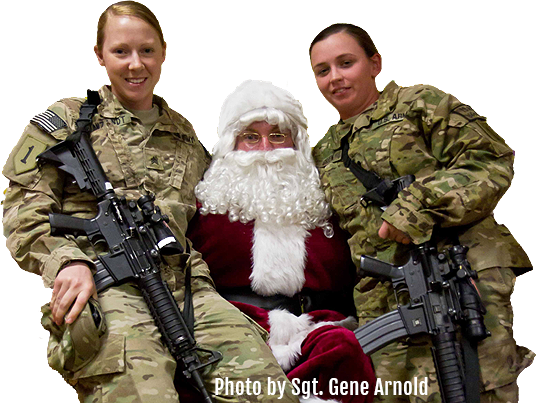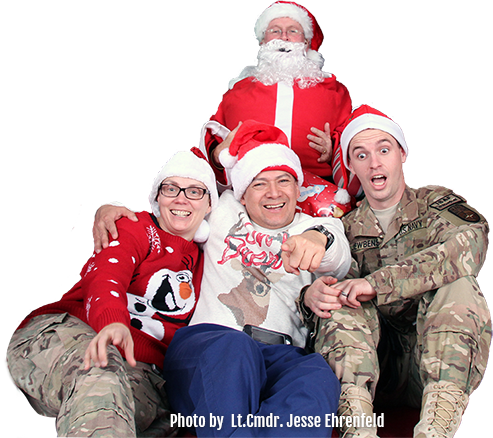Meet Your Military
- Details
- Hits: 5358
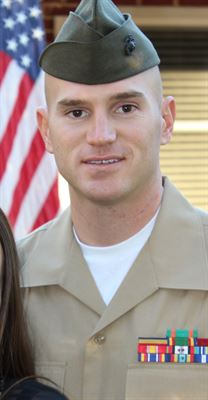 Marine Corps Sgt. Austin Brasington is the station commander for Recruiting Substation Meridian, Miss., where he works to find the future of the Marine Corps. Courtesy photoMERIDIAN, Miss., April 27, 2016 — The alarm goes off at a disquieting volume at five in the morning. Groggily, the sergeant rolls over and quiets his wake-up call. He rubs his eyes, walks to the bathroom, and takes a look at himself. Thoughts begin to fill his head about the day ahead and he begins to calculate how much time he has to do his job and still be home for dinner.
Marine Corps Sgt. Austin Brasington is the station commander for Recruiting Substation Meridian, Miss., where he works to find the future of the Marine Corps. Courtesy photoMERIDIAN, Miss., April 27, 2016 — The alarm goes off at a disquieting volume at five in the morning. Groggily, the sergeant rolls over and quiets his wake-up call. He rubs his eyes, walks to the bathroom, and takes a look at himself. Thoughts begin to fill his head about the day ahead and he begins to calculate how much time he has to do his job and still be home for dinner.
This is the life of a station commander at a recruiting substation, and the story of Marine Corps Sgt. Austin Brasington.
Brasington, a station commander with RSS Meridian, Mississippi, and a native of Montgomery, Alabama, enlisted in 2008 as an aviation ordnance systems technician.
He said that he liked the history of the Marine Corps and the fact that it was the toughest challenge out of all of the service branches.
Read more: Meet Your Military: Marine Corps Recruiter Enjoys Challenges
- Details
- Hits: 7339
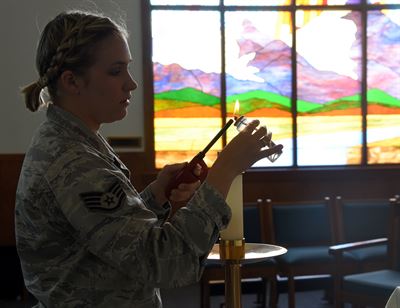 Air Force Staff Sgt. Grace Hoyt, the noncommissioned officer in charge of program support for the 341st Missile Wing’s chapel at Malmstrom Air Force Base, Mont., lights a candle at the base chapel, April 14, 2016. Hoyt came into the Air Force as a space systems operator in 2009, and later cross-trained as a chaplain’s assistant. Air Force photo by Senior Airman Jaeda Tookes MALMSTROM AIR FORCE BASE, Mont., April 26, 2016 — Air Force Staff Sgt. Grace Hoyt is the noncommissioned officer in charge of program support for the 341st Missile Wing’s chapel here.She joined the Air Force in 2009 originally as a space systems operator stationed in Colorado Springs, Colorado."It was amazing to see how much the Air Force impacted the world," Hoyt said. "I loved my job."Hoyt later moved to Vandenberg Air Force Base, California, to work at the Joint Space Operations Center, and later did a second tour as a space systems operator technical school instructor.
Air Force Staff Sgt. Grace Hoyt, the noncommissioned officer in charge of program support for the 341st Missile Wing’s chapel at Malmstrom Air Force Base, Mont., lights a candle at the base chapel, April 14, 2016. Hoyt came into the Air Force as a space systems operator in 2009, and later cross-trained as a chaplain’s assistant. Air Force photo by Senior Airman Jaeda Tookes MALMSTROM AIR FORCE BASE, Mont., April 26, 2016 — Air Force Staff Sgt. Grace Hoyt is the noncommissioned officer in charge of program support for the 341st Missile Wing’s chapel here.She joined the Air Force in 2009 originally as a space systems operator stationed in Colorado Springs, Colorado."It was amazing to see how much the Air Force impacted the world," Hoyt said. "I loved my job."Hoyt later moved to Vandenberg Air Force Base, California, to work at the Joint Space Operations Center, and later did a second tour as a space systems operator technical school instructor.
"When I became an instructor it was different; the rules and regulations were so strenuous," Hoyt said. "I had to retrain my brain to realize I could only help and be involved in the lives of the [airmen] to a certain extent."She said the Air Force wanted to protect the students and the instructors from developing unprofessional relationships, but in so doing she felt they created a lot of walls where she couldn't properly mentor anymore.
Read more: Meet Your Military: Airman Helps Others as Chaplain's Assistant
- Details
- Hits: 7388
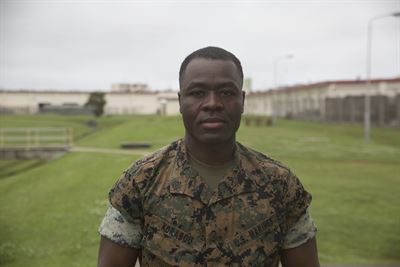 Marine Corps Sgt. Doudoubite Korabou, a mechanic with the 7th Communication Battalion in Okinawa, Japan, served as the chief instructor at III Marine Expeditionary Force Headquarters Group’s corporals’ course. Marine Corps photo by Lance Cpl. Kelsey DornfeldOKINAWA, Japan, April 25, 2016 — After hearing he had been assigned to the position of chief instructor at the III Marine Expeditionary Force Headquarters Group corporals’ course, Marine Corps Sgt. Doudoubite Korabou said his initial thought was, “The shop doesn’t want me; they’re trying to get rid of me.”Only later did he learn that his senior enlisted leaders had selected him as the most qualified Marine to represent the 7th Communication Battalion during the course.Korabou emigrated from Africa to the United States in July 2006. He said his life was not easy once he got to America because he had no knowledge of the culture and only spoke French. He had studied three years of pharmacy before emigrating, and he finished a four-year degree in public health after he arrived in the U.S.In January 2008, with limited knowledge of the Marine Corps, Korabou enlisted as an automotive maintenance technician. Since then, his language skills have improved dramatically, he said.
Marine Corps Sgt. Doudoubite Korabou, a mechanic with the 7th Communication Battalion in Okinawa, Japan, served as the chief instructor at III Marine Expeditionary Force Headquarters Group’s corporals’ course. Marine Corps photo by Lance Cpl. Kelsey DornfeldOKINAWA, Japan, April 25, 2016 — After hearing he had been assigned to the position of chief instructor at the III Marine Expeditionary Force Headquarters Group corporals’ course, Marine Corps Sgt. Doudoubite Korabou said his initial thought was, “The shop doesn’t want me; they’re trying to get rid of me.”Only later did he learn that his senior enlisted leaders had selected him as the most qualified Marine to represent the 7th Communication Battalion during the course.Korabou emigrated from Africa to the United States in July 2006. He said his life was not easy once he got to America because he had no knowledge of the culture and only spoke French. He had studied three years of pharmacy before emigrating, and he finished a four-year degree in public health after he arrived in the U.S.In January 2008, with limited knowledge of the Marine Corps, Korabou enlisted as an automotive maintenance technician. Since then, his language skills have improved dramatically, he said.
Read more: Meet Your Military: Marine Sergeant Leads From the Front
- Details
- Hits: 5641
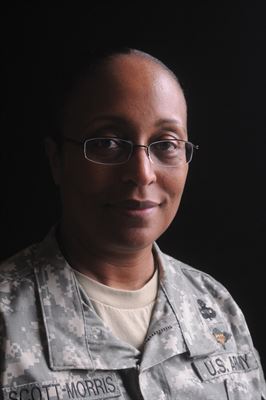 Army Sgt. Maj. Tonika Scott-Morris, sergeant major of the Quartermaster School's Aerial Delivery and Field Services Department, will soon end a 28-year career as a parachute rigger. She is only the second women to hold ADFSD's top enlisted position. Army photo by Terrance Bell FORT LEE, Va., April 8, 2016 — The moment paratroopers leave the relatively safe confines of an aircraft, they relinquish control of their lives to the scales of fate that teeter between life and death.
Army Sgt. Maj. Tonika Scott-Morris, sergeant major of the Quartermaster School's Aerial Delivery and Field Services Department, will soon end a 28-year career as a parachute rigger. She is only the second women to hold ADFSD's top enlisted position. Army photo by Terrance Bell FORT LEE, Va., April 8, 2016 — The moment paratroopers leave the relatively safe confines of an aircraft, they relinquish control of their lives to the scales of fate that teeter between life and death.
Army Sgt. Maj. Tonika Scott-Morris, a self-proclaimed thrill-seeker and the top enlisted rigger at the Quartermaster School’s Aerial Delivery and Field Services Department here, is familiar with that prospect of danger. She has lived with it and helped other airborne-qualified soldiers cope with it for many years.
Scott-Morris, a 48-year-old wife and mother of four, will shortly end a 28-year career as a rigger, logging well over 150 jumps out of an assortment of aircraft without ever feeling the unsettling discomfort of fear.
Read more: Meet Your Military: Sergeant Major Retires Her Jump Boots After 28 Years
- Details
- Hits: 5262
 Army Sgt. 1st Class John Thompson, a UH-60 Black Hawk helicopter standardization instructor with the Minnesota National Guard's 34th Combat Aviation Brigade, found his calling as a unit victim advocate and now volunteers in his local community. Thompson is pursuing a degree in human services and plans to work in a related field once he retires from the military. Minnesota Army National Guard photo by Master Sgt. Blair Heusdens ST. PAUL PARK, Minn., April 6, 2016 — Army Sgt. 1st Class John Thompson sits by his phone, ready to respond at a moment’s notice to assist people who’ve been victimized and are at one of the lowest points in their lives. He’s not a police officer or firefighter, but he often finds himself responding at all hours of the night.
Army Sgt. 1st Class John Thompson, a UH-60 Black Hawk helicopter standardization instructor with the Minnesota National Guard's 34th Combat Aviation Brigade, found his calling as a unit victim advocate and now volunteers in his local community. Thompson is pursuing a degree in human services and plans to work in a related field once he retires from the military. Minnesota Army National Guard photo by Master Sgt. Blair Heusdens ST. PAUL PARK, Minn., April 6, 2016 — Army Sgt. 1st Class John Thompson sits by his phone, ready to respond at a moment’s notice to assist people who’ve been victimized and are at one of the lowest points in their lives. He’s not a police officer or firefighter, but he often finds himself responding at all hours of the night.
Thompson’s experience as a victim advocate in the Minnesota National Guard and as a volunteer in his community has opened his eyes to a problem that persists not only in the military, but also in the civilian world.
“There are a lot of nights that it doesn’t ring, which is a good thing, but there are too many nights that it does. Sometimes it rings more than once and you go out on multiple calls,” he said.
Read more: Meet Your Military: Guardsman Finds New Calling Through Advocacy




